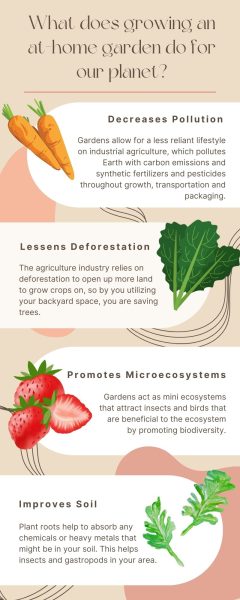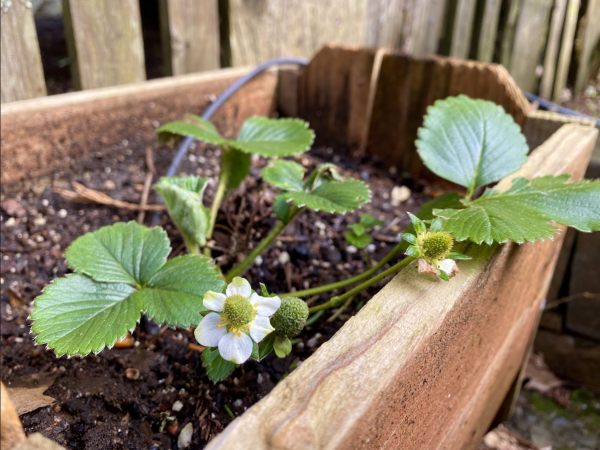Spring is finally upon us, and with that comes the joys of gardening and preparing fresh food from your backyard. Maintaining your own garden can be a fun and sustainable way to have tasty fruits, vegetables and leafy greens at your fingertips. Still, many people often don’t know where to start their gardening journey. Well, have no fear. Along with local plant expert and Sustainable Agriculture teacher Joe Stewart, I am here with the easiest and most plentiful crops the plant world offers.
As you browse your calendar to choose the perfect weekend to take up gardening, you might want to keep in mind a good rule of thumb: always wait to plant your crops until after the last frost of winter.

“You want to wait to do your spring planting until about a month after the average final frost date, which is Feb. 15 [in Marin County]. That means you want to wait until about March 15,” Stewart said.
Marin County typically has a very mild winter — there is no snow, and temperatures rarely drop below 42 degrees. This ideal environment allows plants to thrive, giving gardeners a diverse selection of plants to choose from. Let’s dive into the easiest and most useful plants to have right outside your back door.

Leafy Greens
There are many leafy greens to choose from that would be a great addition to any backyard garden, but the ones that grow most abundantly in Marin are kale, spinach and arugula. All of these can be planted from February through April and will flourish in full sun with fertile, well-drained soil. Having planted these greens for years myself, I can attest that these are extremely hardy and healthy plants to include in any meal. Kale is a popular leafy green that can be used for healthy (and tasty) smoothies, salads and dinners. Both arugula and spinach can also be used for salads and adds a deliciously bold taste.
Squash
Squash is considered a summer and fall crop, but seedlings must be planted in the mid to late spring months of April and May. Often, these sun-loving gourds require an indoor start to ensure their growth, so it is wise to either wait for warmer conditions or plant seedlings inside for three to four weeks before moving them to their permanent homes in the great outdoors.
“If you’re planting from seeds, you’re waiting for a time where [the seeds] are going to get consistent water, either from you or from rain, and it’s not cold because little seedlings don’t do very well in the cold,” Stewart said.
To provide that warmth squashes love, they need substantial sunlight, so pick a hot area in your garden for these photophilics. Zucchini, patty pan and yellow straight neck are all easy and delicious squashes to start your at-home garden as they only require good sun and consistently moist soil.
These scrumptious squashes are a great addition to any meal or snack. One of my favorite things to do with zucchini is to thinly slice and bake it in the oven for 15 minutes at 425 degrees Fahrenheit to make zucchini chips. This dish is a great snack or addition to a full meal. Patty pan and yellow straight neck squash can both be roasted, sautéed or added onto pizzas for semi-sweet and buttery flavors. These vegetables are packed with an abundance of vitamins and dietary necessities, including vitamin C, magnesium, fiber and antioxidants.
Fruits and Other Vegetables
This is the moment I assume you have been waiting for… the fruits, and even more vegetables! There are numerous perennial — meaning plants that last more than just one season — fruits and vegetables that thrive in the northern California climate, such as artichokes, asparagus and many fruit trees (apple, orange, lemon, etc.).

“It’s great to grow fruit trees and those grow year to year, but a tree takes [around] five years before it’s going to produce [fruit] for you,” Stewart said.
This is why I am going to focus primarily on just the annual options of fruits. Cucumbers, carrots, strawberries and bell peppers are all easy and very rewarding foods to try in your new garden. All of these plants need a substantial amount of warmth, so planting these guys in a part of your garden with full sunlight is the way to go.
As you embark on your gardening journey, each plant option in this guide promises to be a beneficial addition to your garden. With attention, love and sun, any plant you pick will be worthwhile. Sustaining an at-home garden reduces carbon emissions greatly by eliminating packaging, transportation and most refrigeration, so this choice isn’t just a fun hobby, it is contributing to the conservation of our wonderful planet. So get that green thumb out!







